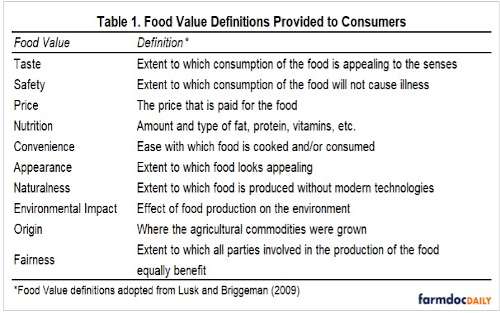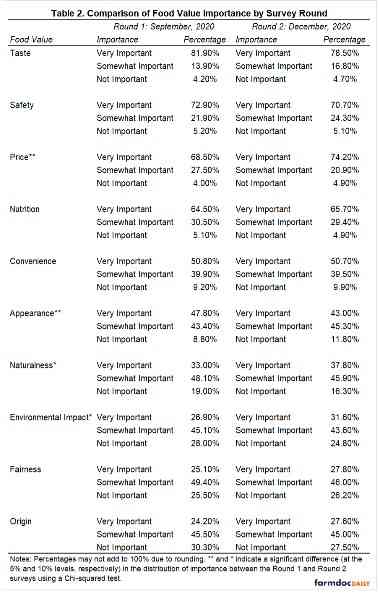By Brenna Ellison
Department of Agricultural and Consumer Economics
University of Illinois
Melissa Ocepek
School of Information Sciences
University of Illinois
There are many factors that influence consumers’ food purchasing decisions – taste, price, appearance, environmental impact, etc. Researchers and marketers alike are interested in the weight consumers place on these different factors, also referred to as “food values”. While research has shown food values to be relatively stable over time (Lusk, 2018), the Covid-19 pandemic has upended all that is normal. Given sustained high unemployment rates (BLS, 2021) and changes in food acquisition options and behaviors (Ellison et al., 2020; Ellison and Ocepek, 2020), it is possible that consumers’ food values have also shifted. In this post, we discuss which food values consumers have traditionally regarded as important and investigate to what extent food values have changed during the Covid-19 pandemic using results from a national survey.
Food Values: A Brief Overview
Researchers and food industry groups have sought to track consumers’ food values over time. The International Food Information Council (IFIC) has been asking consumers to rate the impact of five food values (taste, price, healthfulness, convenience, and environmental sustainability) on their food purchases since 2007. Their results clearly demonstrate that taste is the key driver of food purchases, followed by price, healthfulness, convenience, and environmental sustainability; further, the ordering of values is stable over time (IFIC, 2020). Lusk and Briggeman (2009) investigated a broader set of 11 food values, adding values like appearance, safety, origin, and fairness. Consumers in their study indicated an overwhelming preference for safety but also highly valued taste, nutrition, and price (Lusk and Briggeman, 2009). Lusk (2018) made some modifications to the original set of food values in Lusk and Briggeman (2009) and tracked changes in food values from 2013-2018. Across the 5-year period, taste was consistently the top-rated food value. Further, the top four values (taste, safety, price, and nutrition) clearly dominated the remaining food values (Lusk, 2018).
The Centers for Disease Control and Prevention (CDC) also ran a food values module in the 2009-2010 National Health and Nutrition Examination Survey (NHANES). In this survey, respondents were asked about the importance of taste, nutrition, storability, price, and ease of preparation (Ellison et al., 2020). Burton-Freeman et al. (2018) published results from the NHANES food values module and found that taste and nutrition were most important to consumers while ease of preparation was the least important to consumers.
More recently, Ellison et al. (2020) adapted the NHANES food values module to examine consumers’ food values in the early weeks (March-May, 2020) of the Covid-19 pandemic. Like many other food values studies, Ellison et al. (2020) found taste to be the most important food value. However, they also observed a greater emphasis on the importance of storability compared to previous research (Burton-Freeman et al., 2018). This was likely related to food shortages and stockpiling that occurred early in the pandemic. Now that consumers and the supply chain have had time to adapt, it is important to revisit which food values are driving food purchases.
Survey Design
We conducted online surveys with U.S. consumers in September, 2020 and December, 2020. There were approximately 1,000 survey respondents in each survey round. Respondents were recruited to be representative of the U.S. population in terms of gender, age, income, and geographic region. It is important to note that respondents were not the same for the two survey rounds; rather, we have two, nationally representative samples of consumers.
For our question of interest, we asked consumers to rate the importance of 10 food values (see values and definitions in Table 1). For each value, respondents indicated whether it was very, somewhat, or not important to their food purchase decisions. While consumers were asked to rate the importance of each food value, there were cases where consumers only rated a subset of values. We retained partially complete ratings for analysis (any respondents who failed to rate all 10 values were removed), which results in different numbers of observation for each value. Thus, for ease of comparison, we present our results as shares, or percentages, of consumers who rate each value as very, somewhat, or not important.

Have Consumers’ Food Values Changed During the Covid-19 Pandemic?
Figure 1 presents the food values results for the two consumer samples combined. Similar to previous literature, we find the same top four food values of taste, safety, price, and nutrition, with taste being rated as very important by 80.3% of consumers. Values that were generally less important to consumers were environmental impact, fairness, and origin.
Have Consumers’ Food Values Changed During the Covid-19 Pandemic?
We also investigate whether the importance of food values changed between the two rounds of the survey. Covid-19 cases rapidly increased in November and December, causing many states to introduce new rounds of lockdowns. Further, in December, there was extensive media coverage about the impending expiration of unemployment benefits under the CARES Act. Collectively, these events may have forced some consumers and households to re-evaluate food purchase decisions and the underlying values driving those decisions.
Table 2 presents the importance ratings for each food value by survey round. In both rounds, taste is identified as the most important food value. We find a significant increase in the importance of price during the December round of the survey (74.2% said price was very important in December compared to 68.5% in September). Further, we see a decrease in the importance of the appearance of the food in December (43.0% rated appearance as very important in December vs. 47.8% in September). We also find marginal increases in the importance of naturalness and environmental impact in December, yet these values are still rated as much less important, overall, compared to values like taste, safety, price, and nutrition.

Conclusion
While the Covid-19 pandemic has caused significant shifts in food acquisition and purchasing behaviors, the underlying food values driving those purchases remain largely stable. Like many other studies, we find that consumers want food that tastes good. They also place high importance on safety, price, and nutrition. While we observed changes in the importance of some food values, the overall ordering of food values remained fairly consistent across survey rounds.
Source : illinois.edu